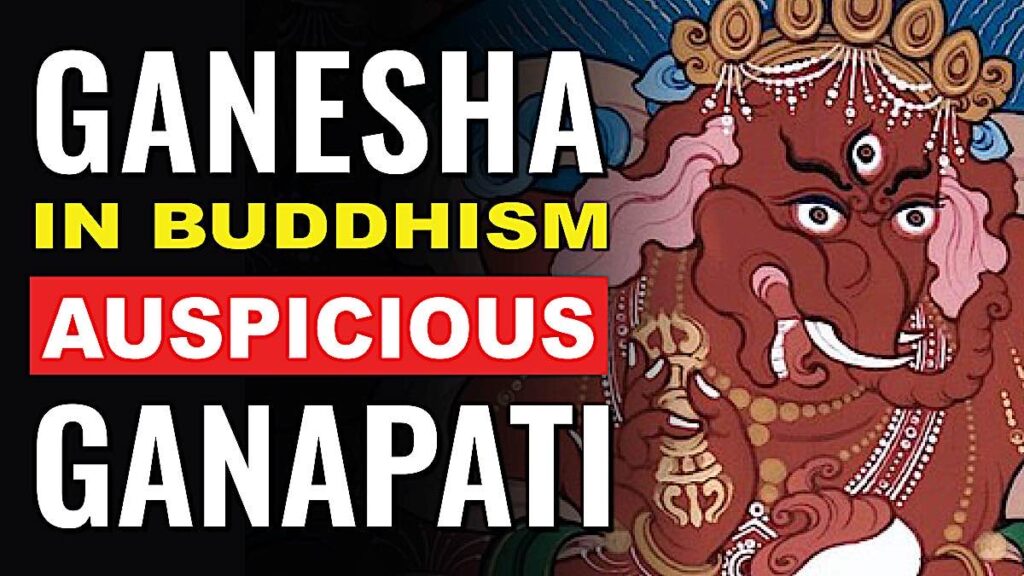- Listen and subscribe on Spotify>>
- Listen and subscribe on Google Podcasts>>
- Listen on our podcast host Buzzsprout>>
- On Stitcher>>
- On iHeart Radio>>
It should also be listed on (or appear shortly on):
- Apple Podcasts
- Google Podcasts
- Apple Music
- Stitcher
- iHeart Radio
- Pandora
- TuneIn+Alexa
- Podcast Addict
- Podchaser
- Pocket Casts
- Deezer
- Listen Notes
- Player FM
- Podcast Index.
Why is Maha Rakta Ganapati recommended by Buddhist Teachers as the remover of obstacles, the protector of prosperity?
Why is Maha Rakta Ganapati recommended by Buddhist Teachers as the remover of obstacles — the protector of prosperity? What makes Ganapati a spiritual superstar? Why is Ganesha so loved around the world? In Buddhism, what makes his practice unique and powerful? Ganapati — the much loved deity Ganesha — transcends spiritual boundaries.
Before we begin, if you like this video, please subscribe to the Spread the Dharma Podcast.
Venerable Zasep Rinpoche, introducing a teaching event, explained his versatile popularity:
“Ganesha is honoured as a Yidam deity as well as a Dharma Protector in both the Hindu tradition and the Tibetan Buddhist tradition. Ganesha is a protector of Dharma practice and prosperity; he also removes hindrances and obstacles.
Ganesha, Vajrayogini, and Kurukulla are the three red deities, part of the thirteen golden Dharmas of the Sakypa tradition of Tibetan Buddhism.
Ganesha is one of the fifteen directional protectors – in that group he is known as a Vinayaka.”

Ganapati in Found in Most Schools of Buddhism
Ganapati practice is pervasive and popular in most schools of Buddhism, including Mahayana and Vajrayana. Zasep Rinpoche illustrated with this example:
“Ganesha also promised to protect the Dharma in front of Guru Padmasambhava. Guru Padmasambhava composed 108 Sadhanas of Ganesha and gave them to Tibet’s second great king.”
Rinpoche also explained that there are 32 aspects of Ganesha in Hinduism and several in Buddhism, including as an aspect of Chenrezig.
The Story of Avalokiteshvara and Ganesha
From the chapter of Ganesha-Ganapati in Zasep Rinpoche’s book Source of All Buddhist Protectors, he synopsized the charming story of how Avalokiteshvara — in Tibetan known as Chenrezig — “convinced” Ganesha to protect the Buddha Dharma:
“Chenrezig knew Ganesha was a powerful god and wanted him to become a Dharma protector. Chenrezig decided the only way to do this was to manifest as an even more powerful Ganesha. One day Ganesha and his attendants went on an outing… While they were gone Chenrezig manifested himself as Ganesha and entered the royal palace. The consort of Ganesha and her entourage greeted him and offered flowers and music….when the real Ganesha returned to the royal palace, the consort and entourage were very confused and told him the great Maha Deva Ganapati was already sitting on the golden throne! … Then Ganesha, seeing the power and wisdom of Chenrezig, right away he took refuge and the Bodhisattva vows from him, to protect and maintain the holy Dharma.”
Benefits of Ganesha’s Dharani
Ganapati’s Heart Dharani is a Sutra proclaimed by Shakyamuni Buddha in the Arya Ganapati Hridaya. In the sutra, Buddha suggested Ganapati’s dharani be practiced first, before other practices and meditations, to help remove obstacles to practice. Buddha said to Venerable Ananda:
“Retain this, the Heart of Ganapati. The people who read this will accomplish all their endeavors. All the aspirations they hold in their minds will be accomplished as well. They will accomplish all the secret mantras, too. All their wealth and resources will become abundant.”
Venerable Zasep Rinpoche wrote:
“At the time of Buddha Shakyamuni, Buddha advised his chief disciple Maha Ananda, that the monks, nuns and lay devotees should first take refuge in the Buddha, Dharma and Sangha, then make offerings to Ganesha. They should recite his Mantras seven times, twenty-one times or 108 times, then they could achieve their wishes and remove obstacles to Dharma practice.”
The shortest version of the mantra would be:
OM AH GA HUM SVAHA
In simple terms: Om Ah and Hum respectively represent Buddha’s Body, Speech and Mind and GA is the seed-syllable of Ganapati Ganesha.
Prayer to 12-armed Ganapati
Traditionally, devotees would make a daily offering of flowers, carrots and other sweet offerings with a simple prayer such as:
Lord Ganapati, you are the embodiment of
Body, Speech and Mind of the Buddhas
Arising from non-dual wisdom,
I offer fragrant flowers, carrots and other substances,
To you, the Lord who removes obstructors,
I pray to you and your entourage,
Please send your blessings and siddhas upon us!
Siddhas can be loosely translated as “wish-granting.” Depending on context it has many meanings, including the greatest of Siddhis — Enlightenment.
The Wish-Granting Ganapati with 12 Arms
Ngorchen Konchog Lhundrup, who lived from 1497 to 1557, described Great Red Ganesha as standing “beside a lapis lazuli rock mountain on a red lotus with eight petals…a blue rat expelling various jewels. Shri Ganapati with a body red in colour, having an elephant face with sharp white tusks and possessing three eyes, black hair tied in a topknot with a wishing-gem and a red silk ribbon in a bundle on the crown of the head. He has twelve hands. With the six right hands he holds an axe, arrow, hook, vajra, sword and spear. The six left hands hold a pestle, bow, khatvanga, skullcup filled with nectar and a shield together with a spear and banner. The peaceful right and left hands are signified by the vajra and skull cup held to the heart. The remaining hands are displayed in a threatening manner. Wearing various silks as a lower garment and adorned with a variety of jewel ornaments, the left foot is extended in a dancing manner, standing in the middle of the bright rays of red flickering light.”
Ganapati — Clears Away Obstacles
As the clearer of obstacles, he often appears prominently in many mandalas and Thangkas, or at the door of the temple or home. For example, we see Red 12-Armed Ganapati at the top left, in the prominent position on this Thangka of Hayagriva.
As remover of obstacles, he is a vital symbol and Enlightened Deity. Ganapati clears away obstacles, obscuration’s — and supports our practice. Ganesha practice is foundational and supportive and is beneficial as a precursor to any Buddhist practice. For many of us, Ganesha is our main devotional or meditational practice.




